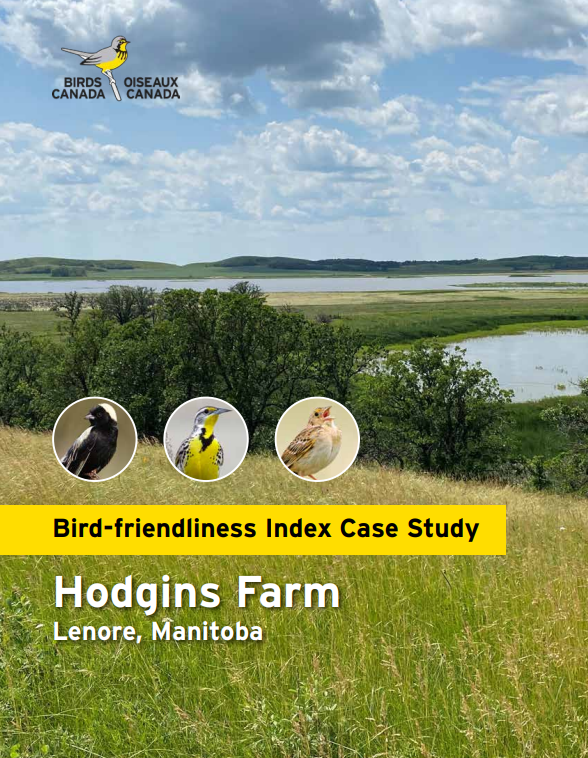Ian Cook, Grassland Conservation Manager at Birds Canada
In the rolling hills outside the village of Lenore, Manitoba, Hodgins Farm is proving that farming and conservation can go hand in hand. Run by Lisa and Cameron Hodgins and their four children, this intergenerational family farm has embraced regenerative agriculture, transforming their land into a sanctuary for birds and other wildlife.
Their efforts are not just anecdotal—thanks to Birds Canada’s innovative Bird-friendliness Index (BFI), the positive impact of Hodgins Farm on local bird populations is both measurable and significant.
Over the past four years, Birds Canada has been adapting the BFI to the unique conditions of the Canadian Prairies, thanks to the generous support of Birds Canada’s supporters.

Hodgins Farm, Manitoba. Photo: Ian Cook
The Bird-friendliness Index is an innovative tool developed by Birds Canada to measure and communicate bird conservation impact, from a farm level. The BFI considers two inputs: how many birds are on a farm and their conservation status. Bird communities on farms are compared to the bird community in the surrounding landscape to determine how each farm compares to its regional context. A site’s BFI score is reported as a single number between 0 and 1 that describes whether the farm or ranch is better or worse for birds than average conditions in the surrounding landscape. A farm that has a BFI value over 0.5 is providing above-average benefits to birds within its regional context.
The BFI focuses primarily on grassland birds, a group facing urgent conservation challenges across the Canadian Prairies. By evaluating bird communities on farms and comparing them to those in the surrounding landscape, the BFI provides a clear measure of how farms like Hodgins’ are supporting bird conservation.
Hodgins Farm has been participating in this project since the beginning, allowing bird surveys to be conducted by Birds Canada from 2021 to 2023. The results speak volumes about the Hodgins’ commitment to biodiversity.

The Hodgins Family. Photo: Lisa Hodgins
Hodgins Farm achieved an average BFI score of 0.76—well above the average for the surrounding landscape. This high score reflects the farm’s significant contributions to the conservation of Species at Risk and the persistence of common bird species. By eliminating pesticides, conserving natural habitats, and incorporating perennial cover, the Hodgins have created an environment where birds can thrive.
The BFI data reveals that Hodgins Farm is a haven for grassland birds, many of which are in steep decline. The farm is home to large populations of Bobolink, Western Meadowlark, and Eastern Kingbird. Notably, Hodgins Farm has double the density of Western Meadowlarks and sixty times more Grasshopper Sparrows per hectare than the surrounding landscape. These birds, which rely on grassland habitats, are thriving thanks to the Hodgins’ regenerative farming practices.

Hodgins Farm is home to large populations of Bobolink. Photo: Brenda Doherty
Hodgins Farm exemplifies how the BFI can be used to measure, communicate impacts and ultimately reward farmers and ranchers who support bird conservation. The BFI is not just a measurement tool; it’s a way to inspire and reward farmers who prioritize conservation. The success of Hodgins Farm demonstrates that with the right tools and support, farmers can play a crucial role in conserving Canada’s bird populations.
Your support of Birds Canada’s work on the Prairies has allowed for this important work, you can learn more about the BFI by reading the BFI Summary and Hodgins Farm Case Study. We put together these documents to communicate just how important this tool can be to recovering birds and biodiversity in working landscapes.
You can also learn more about our work to conserve grassland birds by visiting birdscanada.org/grasslands or by listening to a recent episode of The Warblers podcast: Grasslands, Birds and Beef.

